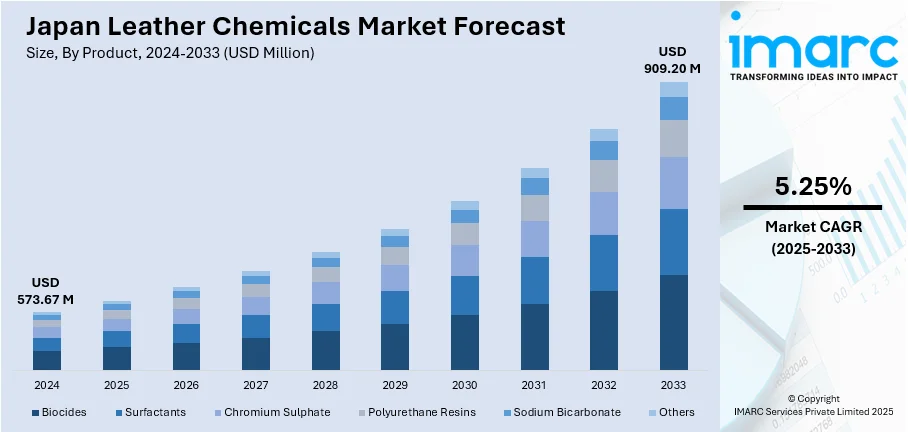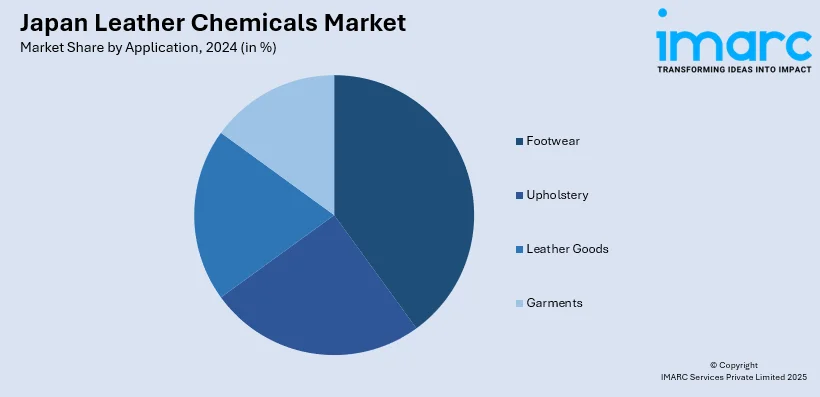
Japan Leather Chemicals Market Size, Share, Trends and Forecast by Product, Process, Application, and Region, 2025-2033
Japan Leather Chemicals Market Overview:
The Japan leather chemicals market size reached USD 573.67 Million in 2024. Looking forward, IMARC Group expects the market to reach USD 909.20 Million by 2033, exhibiting a growth rate (CAGR) of 5.25% during 2025-2033. The market is fueled by the increasing demand for high-grade leather products across automotive, fashion, and furniture industries. Rising consumer inclination toward environmentally friendly and sustainable leather processing technologies also fuels market growth as companies aim to curb environmental impact. Furthermore, progress in leather chemical formulations, coupled with the growth in the automotive and footwear industries, continues to augment the Japan leather chemicals market share.
|
Report Attribute
|
Key Statistics
|
|---|---|
|
Base Year
|
2024 |
|
Forecast Years
|
2025-2033
|
|
Historical Years
|
2019-2024
|
| Market Size in 2024 | USD 573.67 Million |
| Market Forecast in 2033 | USD 909.20 Million |
| Market Growth Rate 2025-2033 | 5.25% |
Japan Leather Chemicals Market Trends:
Shift Toward Eco-Friendly Leather Processing
The market is also seeing a strong shift towards green and sustainable leather processing. This is greatly influenced by growing concerns about the environment among consumers, the pressure of regulations, and sustainability requirements in production. Conventional methods of tanning and finishing leather usually contain toxic substances, including chromium salts, which are hazardous to the environment and human health. Therefore, firms are implementing substitute, eco-friendly processes, including vegetable tanning, chrome-free tanning, and the utilization of biodegradable finishing chemicals. Apart from this, greater investment in developing leather chemicals that minimize water and energy usage during production. A study published in June 2024 examined an AI-assisted method to optimize the chrome tanning process in the leather industry for energy efficiency and carbon reduction. By evaluating four machine learning models, the researchers identified BP-ANN and SVR as the most effective in predicting optimal process parameters while maintaining product quality. The optimized process, validated through product performance testing, demonstrated potential annual savings of 8,353 kgce in energy and 87,296 kgCO₂ emissions for a standard tannery, offering a viable pathway for low-carbon leather manufacturing. As sustainability becomes a key factor in consumer purchasing decisions, Japanese manufacturers are increasingly focusing on the use of renewable resources and waste reduction strategies. These changes not only meet environmental standards but also align with global sustainability trends, which is positively impacting the Japan leather chemicals market growth.

To get more information on this market, Request Sample
Growing Demand from Automotive and Footwear Sectors
The automotive and footwear sectors are experiencing substantial growth in Japan, contributing significantly to the demand for leather chemicals. In the automotive industry, leather is used for car interiors, seat covers, steering wheels, and upholstery, where performance, comfort, and good looks are critical factors. As Japan's automotive industry leans towards technological innovations, like electric cars and autonomous driving, high-quality leather materials have become more in demand, necessitating specialized chemicals for leather. The Japanese footwear business is also growing, as leather continues to be a material of choice for designer and luxury sneakers due to its durability and comfort. As per an industry report, The Japan footwear market is anticipated to reach USD 16.0 Billion by 2033 with a growth rate (CAGR) of 2.66%. This has led to an increase in the demand for leather chemicals that provide superior finish, color retention, and resilience. As both markets develop, the focus for manufacturers is on leather chemical formulation innovations that will improve performance, including water resistance and breathability, thereby addressing the evolving demands of the automotive and footwear industries.
Japan Leather Chemicals Market Segmentation:
IMARC Group provides an analysis of the key trends in each segment of the market, along with forecasts at the country and regional levels for 2025-2033. Our report has categorized the market based on product, process, and application.
Product Insights:
- Biocides
- Surfactants
- Chromium Sulphate
- Polyurethane Resins
- Sodium Bicarbonate
- Others
The report has provided a detailed breakup and analysis of the market based on the product. This includes biocides, surfactants, chromium sulphate, polyurethane resins, sodium bicarbonate, and others.
Process Insights:
- Tanning and Dyeing
- Beamhouse Chemicals
- Finishing Chemicals
A detailed breakup and analysis of the market based on the process have also been provided in the report. This includes tanning and dyeing, beamhouse chemicals, and finishing chemicals.
Application Insights:

- Footwear
- Upholstery
- Leather Goods
- Garments
The report has provided a detailed breakup and analysis of the market based on the application. This includes footwear, upholstery, leather goods, and garments.
Regional Insights:
- Kanto Region
- Kansai/Kinki Region
- Central/ Chubu Region
- Kyushu-Okinawa Region
- Tohoku Region
- Chugoku Region
- Hokkaido Region
- Shikoku Region
The report has also provided a comprehensive analysis of all the major regional markets, which include Kanto Region, Kansai/Kinki Region, Central/ Chubu Region, Kyushu-Okinawa Region, Tohoku Region, Chugoku Region, Hokkaido Region, and Shikoku Region.
Competitive Landscape:
The market research report has also provided a comprehensive analysis of the competitive landscape. Competitive analysis such as market structure, key player positioning, top winning strategies, competitive dashboard, and company evaluation quadrant has been covered in the report. Also, detailed profiles of all major companies have been provided.
Japan Leather Chemicals Market News:
- On October 29, 2024, Mitsubishi Chemical Group announced that its plant-derived polyol, BioPTMG, which comprises about 92% biomass content has been adopted by Kahei Co., Ltd. The product is used in bio-synthetic leather products such as bags. This material offers flexibility and resilience while reducing petroleum usage and supporting CO₂ emission reductions. The collaboration aligns with Kahei's commitment to eco-friendly manufacturing and contributes to the advancement of sustainable materials in the leather industry.
Japan Leather Chemicals Market Report Coverage:
| Report Features | Details |
|---|---|
| Base Year of the Analysis | 2024 |
| Historical Period | 2019-2024 |
| Forecast Period | 2025-2033 |
| Units | Million USD |
| Scope of the Report |
Exploration of Historical Trends and Market Outlook, Industry Catalysts and Challenges, Segment-Wise Historical and Future Market Assessment:
|
| Products Covered | Biocides, Surfactants, Chromium Sulphate, Polyurethane Resins, Sodium Bicarbonate, Others |
| Processes Covered | Tanning and Dyeing, Beamhouse Chemicals, Finishing Chemicals |
| Applications Covered | Footwear, Upholstery, Leather Goods, Garments |
| Regions Covered | Kanto Region, Kansai/Kinki Region, Central/ Chubu Region, Kyushu-Okinawa Region, Tohoku Region, Chugoku Region, Hokkaido Region, Shikoku Region |
| Customization Scope | 10% Free Customization |
| Post-Sale Analyst Support | 10-12 Weeks |
| Delivery Format | PDF and Excel through Email (We can also provide the editable version of the report in PPT/Word format on special request) |
Key Questions Answered in This Report:
- How has the Japan leather chemicals market performed so far and how will it perform in the coming years?
- What is the breakup of the Japan leather chemicals market on the basis of product?
- What is the breakup of the Japan leather chemicals market on the basis of process?
- What is the breakup of the Japan leather chemicals market on the basis of application?
- What is the breakup of the Japan leather chemicals market on the basis of region?
- What are the various stages in the value chain of the Japan leather chemicals market?
- What are the key driving factors and challenges in the Japan leather chemicals market?
- What is the structure of the Japan leather chemicals market and who are the key players?
- What is the degree of competition in the Japan leather chemicals market?
Key Benefits for Stakeholders:
- IMARC’s industry report offers a comprehensive quantitative analysis of various market segments, historical and current market trends, market forecasts, and dynamics of the Japan leather chemicals market from 2019-2033.
- The research report provides the latest information on the market drivers, challenges, and opportunities in the Japan leather chemicals market.
- Porter's five forces analysis assist stakeholders in assessing the impact of new entrants, competitive rivalry, supplier power, buyer power, and the threat of substitution. It helps stakeholders to analyze the level of competition within the Japan leather chemicals industry and its attractiveness.
- Competitive landscape allows stakeholders to understand their competitive environment and provides an insight into the current positions of key players in the market.
Need more help?
- Speak to our experienced analysts for insights on the current market scenarios.
- Include additional segments and countries to customize the report as per your requirement.
- Gain an unparalleled competitive advantage in your domain by understanding how to utilize the report and positively impacting your operations and revenue.
- For further assistance, please connect with our analysts.
 Request Customization
Request Customization
 Speak to an Analyst
Speak to an Analyst
 Request Brochure
Request Brochure
 Inquire Before Buying
Inquire Before Buying




.webp)




.webp)












